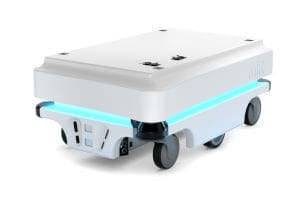Automated Removal of Waste & Recycling Material
Waste and recycling removal is a basic yet frequently recurring task in warehouses and production operations, but it can be difficult and time-consuming for employees to handle manually or via fork truck. It’s not a glorious job in the supply chain, but the waste stream must be addressed to keep the operation running with efficiency.
Removal of waste and recycling with autonomous mobile robots (AMRs) is becoming a common way to take advantage of robotics technology in industry. As companies turn to robotics to help with waste management tasks, they find that the autonomous mobile robot offers many benefits over traditional manual labor.
The downsides of using employees for manual waste material and recycling removal
One of the downsides of using humans to manually remove waste and recycling is that it can be physically demanding and repetitive work. This can lead to employee fatigue and injuries, which can cause lost productivity and increased healthcare costs. Additionally, manual waste and recycling removal can be time-consuming, taking employees away from other important tasks.
Alleviating the labor shortage with AMRs
One of the major challenges that companies face today is attracting enough employees to work in warehouses. With unemployment rates at historic lows, it can be difficult to find and retain warehouse workers to perform manual labor tasks such as recycling and waste material removal. This can lead to slower production and lost productivity, as companies struggle to keep up with demand.
Autonomous mobile robots can help to reduce the number of people needed to staff a warehouse or production facility. These robots are able to work around the clock and can handle tasks such as waste and recycling removal with minimal supervision. This means that companies can rely on robots to perform these tasks, rather than hiring additional human workers. With the help of robots, companies can increase productivity and reduce labor costs, as they will not have to spend as much on employee salaries, benefits and training. Additionally, companies can avoid the problem of employee turnover and the difficulty of recruiting new employees.
It’s important to note that, while robots can help to reduce the number of people needed to staff a warehouse, they are not meant to replace human employees entirely. Instead, they are meant to complement human workers, by handling repetitive and physically demanding tasks such as waste material removal. This allows human workers to focus on more complex and higher-level tasks, such as quality control and customer service.
AMRs are ideally suited for tasks such as waste and recycling removal
AMRs are ideally suited for frequently recurring tasks such as waste and recycling removal. These warehouse robots are equipped with artificial intelligence and sensors and cameras that allow them to navigate through warehouses and production operations. AMRs can be programmed to perform specific tasks, such as picking up waste material or recycling bins and returning empty containers. AMRs work around the clock, eliminating disruptions due to sick time and staff call-outs.
How do companies benefit from AMRs?
There are many ways in which a company can benefit from having robots handle waste and recycling removal tasks. For one, robots can work much more quickly and efficiently than human workers, which can help to increase productivity and reduce costs. Additionally, robots are not susceptible to injuries or fatigue, so they can work safely and reliably over long periods of time. This means that they can handle more waste and recycling removal tasks than human workers, and they can do so with less supervision.
ROI: Quantifying the benefits of autonomous robots
The amount of benefit a company will realize by adopting autonomous robots for waste and recycling removal tasks depends on several factors. For example, the size of the warehouse or production operation will play a role, as larger operations have more travel distance which can potentially be eliminated for the staff. Next, the frequency of the removal task (and the number of shifts) will determine how much travel time is saved for the staff. Finally, the type of waste and recycling materials that need to be removed will also be a factor, as some materials may be more difficult for robots to handle than others.
The benefits of an expert AMR consultant such as CSSI
If a company is interested in implementing autonomous robots to handle waste and recycling removal tasks, it will likely want to work with a consultant who specializes in this area. An expert consultant such as CSSI can help the company to assess its needs and determine the best mobile robot for the specific operation. A consultant such as CSSI will also assist with the implementation of the robots, including the programming and integration of the robots into the company’s existing systems. Also, a consultant like CSSI can help with the training of employees who will be working with the robots, and can provide ongoing support and maintenance for the robots.
In conclusion, using autonomous mobile robots for the removal of waste and recycling material in warehouses and production operations is a growing trend. With the ability to work quickly and efficiently, robots help increase productivity and reduce costs while also reducing the risk of employee injuries and fatigue. Companies can benefit by working with a consultant who specializes in this area to help with the implementation of robots and the ongoing support and maintenance. With the help of robots, companies can make the process of waste and recycling removal more efficient, safe and cost-effective.
Discuss Waste and Recycling Removal Via AMRs With CSSI
You can learn more about autonomous mobile robot solutions available through CSSI by clicking here. Or begin your journey with completing the form below. We will be happy to speak with you to identify the optimal use case with which to begin your adoption of .






